Psychology
Dr. George W. Crane’s H-E-L-P Formula
A nugget of applied psychology wisdom from the 1960s: How young women could avoid date rape, according to Dr. George W. Crane, a well-known psychologist and newspaper columnist — "Girls, if you can keep your escort talking, you can ward off assault, even by a vicious rapist! So ply him with questions! Keep him talking! Praise some of his good points but always fade out of your part of the dialogue with a question mark!"Crane's logic was that, "A man cannot engage in gay conversation and meanwhile be sexually passionate! For these are opposing actions!" He offered the H-E-L-P formula as a mnemonic to help women keep the 'gay conversation' going. The idea was that they should quiz a potential assailant about Hobbies, Entertainment, Literature, and Politics, in that order.
There's more about Crane on Wikipedia. Apparently he developed the first computer dating organization. There's also this:
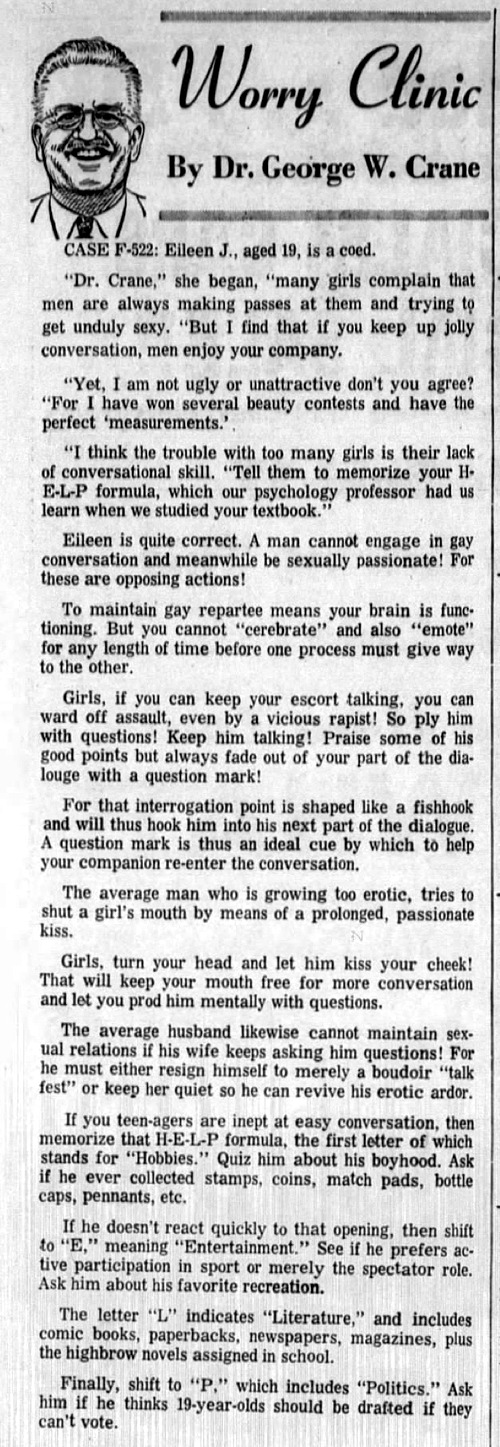
Mansfield News-Journal - Mar 21, 1968
Posted By: Alex - Wed Oct 17, 2018 -
Comments (8)
Category: Psychology, 1960s
The Initials Effect
Found by psychologist Nicholas Christenfeld. The effect is that if the initials of your name spell out something positive (such as J.O.Y. or G.O.D.) you'll likely live longer than someone whose initials spell out something negative (B.A.D. or A.S.S.).From his article in the Journal of Psychomatic Research (Sep 1999):
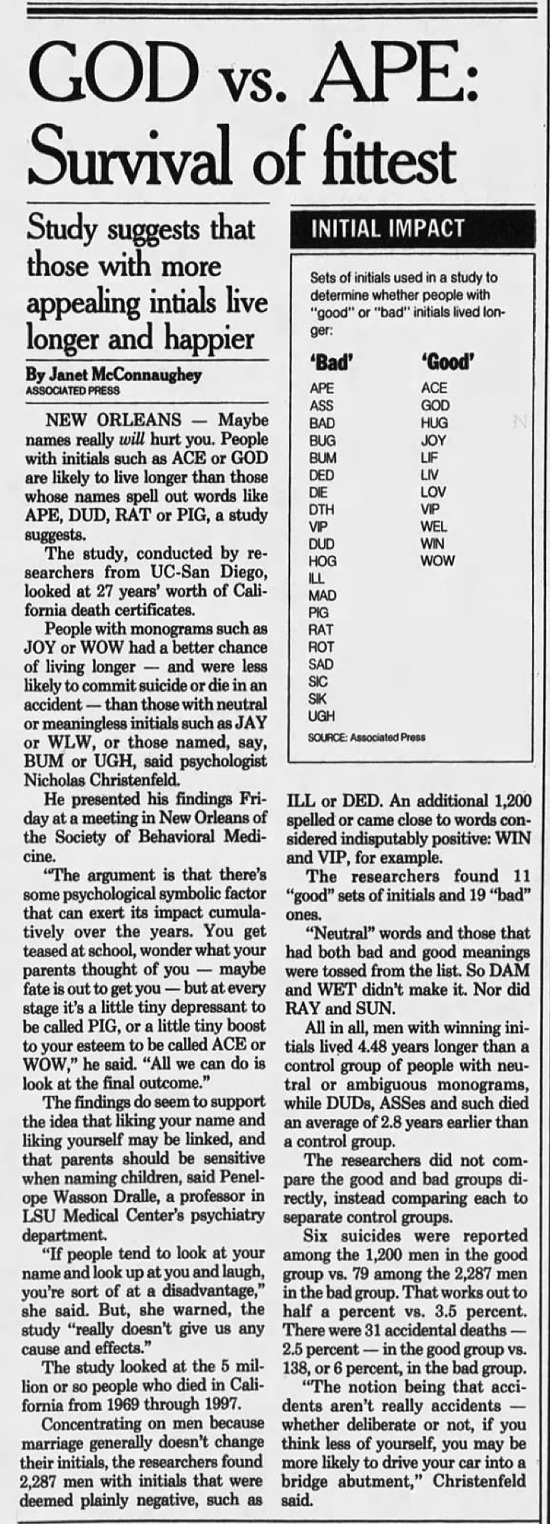
San Francisco Examiner - Mar 28, 1998
Posted By: Alex - Wed Sep 05, 2018 -
Comments (4)
Category: Odd Names, Science, Psychology
Dentists smell fear
Recent research reveals that dentists can not only smell fear, but that when they do their job performance significantly declines. From New Scientist:Next, examiners graded the dental students as they carried out treatments on mannequins dressed in the donated T-shirts. The students scored significantly worse when the mannequins were wearing T-shirts from stressful contexts. Mistakes included being more likely to damage teeth next to the ones they were working on.
So, if your fear causes your dentist to start making more mistakes, I assume that will only increase your fear, causing your dentist to make even more mistakes, leading to a downward-spiraling cycle of terror.
The academic study is here.

Posted By: Alex - Tue Jun 05, 2018 -
Comments (4)
Category: Experiments, Psychology, Teeth
Wedding with lie detector
A lie detector used at the 1932 wedding of Harriet Berger and Vaclav Rund determined that their love was true.Vaclav and Harriet were still together in 1940, according to the census. So, score one for the lie detector. I haven't been able to trace their marriage any later than that. Though a V.R. Rund of the correct location and birth year died in 1989.
(Some media sources listed the bridegroom's name as Vaclaw Hund, but I think 'Rund' was his correct name, given the census data.)
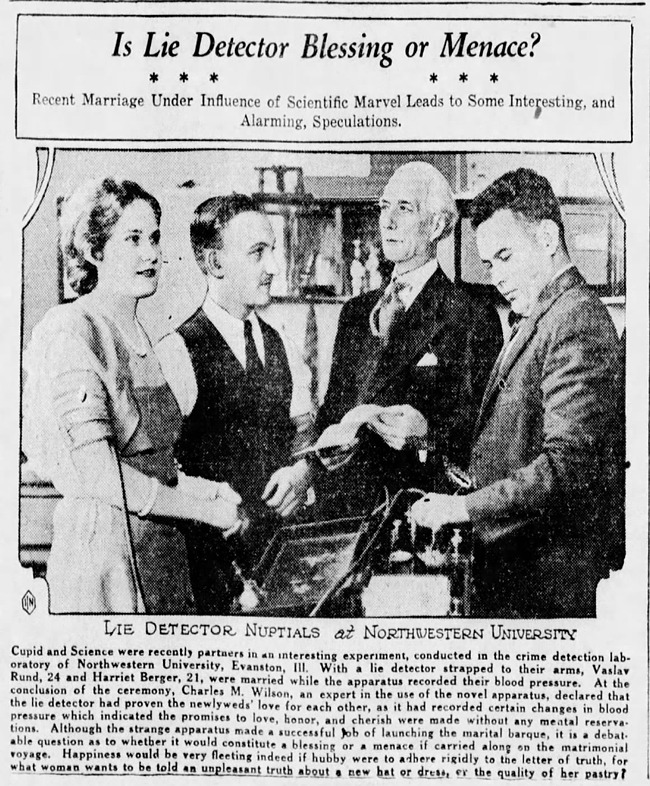
Albuquerque Journal - June 14, 1932
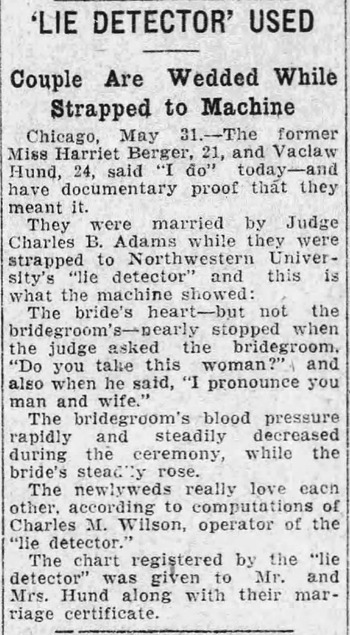
Sioux Falls Argus-Leader - June 1, 1932
Posted By: Alex - Mon Jun 04, 2018 -
Comments (0)
Category: Psychology, 1930s, Weddings
Cheerleader Effect

image source: dwilliss/flickr
Pro-tip for non-photogenic people: You'll look better in a group photo than on your own. This is known as the Cheerleader Effect, and it's been scientifically verified. From medicalxpress.com:
Participants rated the attractiveness of faces presented in a group and individually. Regardless of gender, attractiveness ratings were higher when people were presented in a group compared to presented individually.
However, this does not mean the bigger the group—the more attractive you are. The authors found that group size, whether 4, 9, or 16 individuals, had no effect on attractiveness ratings. Basically, a handful of friends is all you need to take advantage of this effect.
Importantly, studies have shown the cheerleader effect to be reliable. Additional studies published in 2015 and one just this month continue to find a groups' attractiveness is significantly higher than the attractiveness of an individual group member.
Posted By: Alex - Sun Mar 04, 2018 -
Comments (2)
Category: Beauty, Ugliness and Other Aesthetic Issues, Psychology
Hypnotizing the voters
Nick Belluso, while running for governor of Georgia in 1978, came up with the idea of hypnotizing the voters to vote for him. So he hired a hypnotist and created a TV ad which went as follows:Hypnotist: Do not be afraid. I am placing the name of Nick Belluso in your subconscious mind. You will remember this. You will vote on Election Day. You will vote Nick Belluso for governor. You will remember this. You will vote on Election Day. You will vote Nick Belluso for governor.
However, Belluso's scheme was foiled when every TV station but one refused to run the ad, fearing the hypnosis might actually work, which would open them up to potential legal liabilities.
So Belluso lost the election. Though he subsequently became a perennial candidate running for many offices, including President of the United States in 1980.
You can see most of the ad in the clip below.
Also worth noting: Belluso claimed he had been endorsed by "The Force."
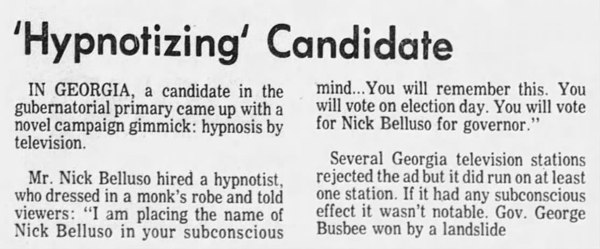
The Nashville Tennessean - Aug 11, 1978

Posted By: Alex - Thu Jan 25, 2018 -
Comments (2)
Category: Hypnotism, Mesmerism and Mind Control, Politics, Psychology, 1970s
Dr. Blatz’s Trick Chair of Terror
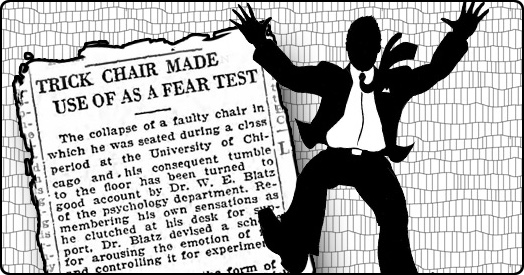
While he was a grad student at the University of Chicago in the early 1920s, William Blatz was sitting in class one day, leaning back in his chair, when suddenly the chair collapsed beneath him, sending him sprawling backwards, crying out in fright. The experience was unsettling, but it gave him an idea for an unusual psychology experiment.
He designed a trick chair that would collapse backwards without warning when he flipped an electric switch. The chair was padded, so its occupant wouldn't get hurt. But Blatz figured that the sensation of abruptly, unexpectedly falling backwards would provoke a strong, measurable reaction in subjects. This would allow him to study the physiology of fear under controlled, repeatable conditions. He performed his experiment on a series of unsuspecting victims.
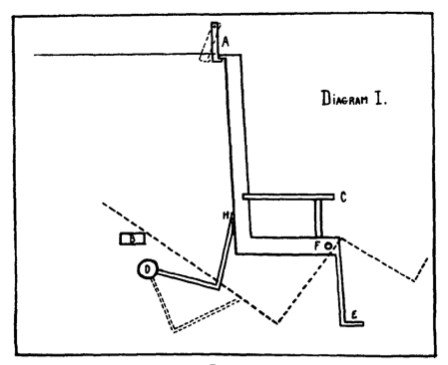
Diagram of Blatz's trick chair.
When the hook (A) at the top was released, the chair plunged backwards.
More in extended >>
Posted By: Alex - Tue Dec 26, 2017 -
Comments (2)
Category: Experiments, Psychology, 1920s
Personal body space
As the population increases, we will all have to learn to accept strangers on the street standing very close to us.According to recently collected facts, there were three basic reactions: (1) He-she slowly backed away as the interviewer got closer, (2) He-she struck a defensive pose such as folding arms, looking down, or even turning to one side, and (3) No reaction, though most people do have some kind of reaction...
According to Mark, most people have this "wall" about 18 inches around them that excludes all people from entering. What the interviewers were doing when they moved closer to the person was violating personal body space, causing them to react.
Steve says, "It's a shame this happens because as our world gets more and more crowded, we'll have to get closer together. Let's all start getting closer together and break down that wall."
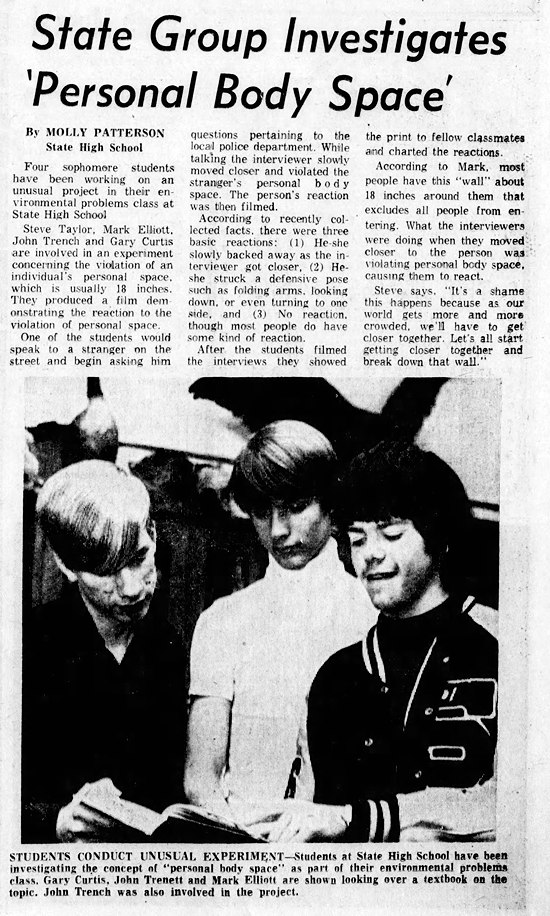
Terre Haute Tribune - Mar 31, 1974
Posted By: Alex - Mon Dec 18, 2017 -
Comments (5)
Category: Experiments, Psychology, 1970s
Service for smiles
Given an equal choice, will a store clerk first serve a smiling or a frowning customer?Science provides the answer. Clerks go toward the smiler.
Maybe this is why it's so hard to ever get help in Home Depot. I need to be grinning more.
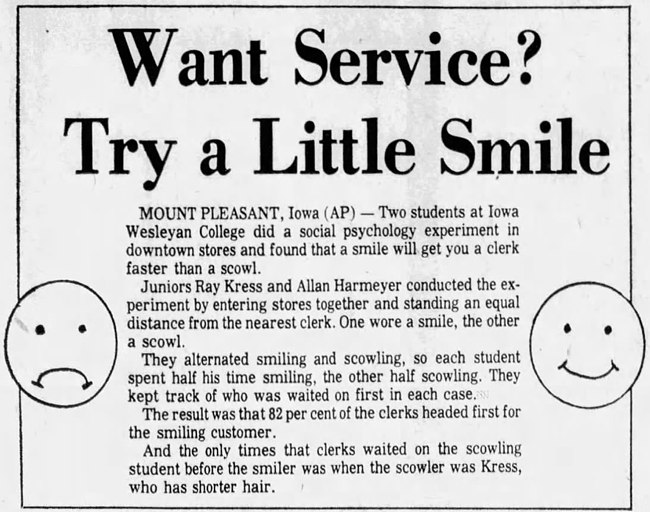
Elmira Star Gazette - Dec 11, 1972
Posted By: Alex - Thu Nov 30, 2017 -
Comments (3)
Category: Science, Psychology, Shopping
Bikini Experiment
So why was Simone Harris standing on a Sydney street in a bikini? Was this a publicity stunt? Was she a psychologist conducting research? A performance artist being weird? I haven't been able to find answers anywhere.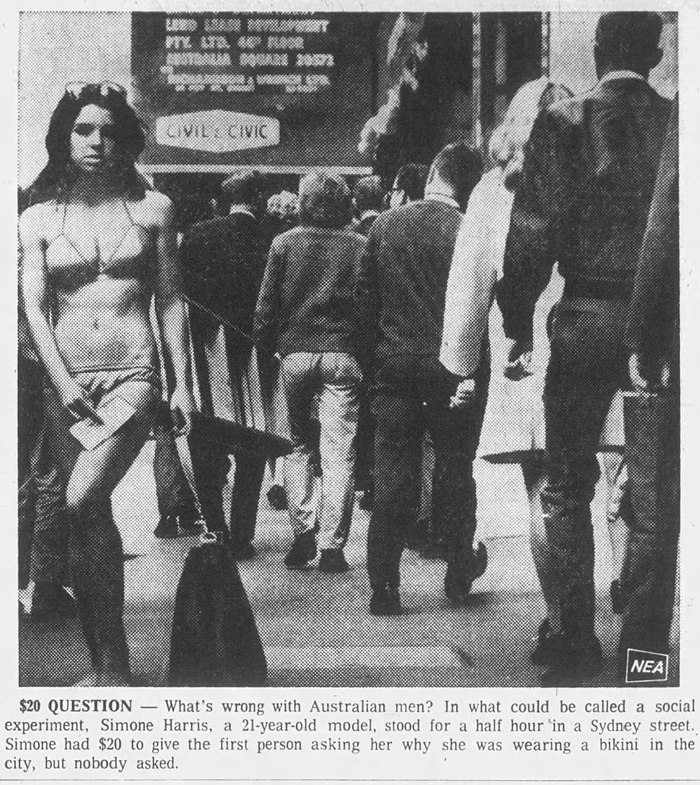
Racine Journal Times - June 17, 1970
Posted By: Alex - Wed Nov 15, 2017 -
Comments (2)
Category: Experiments, Psychology, 1970s

| Who We Are |
|---|
| Alex Boese Alex is the creator and curator of the Museum of Hoaxes. He's also the author of various weird, non-fiction, science-themed books such as Elephants on Acid and Psychedelic Apes. Paul Di Filippo Paul has been paid to put weird ideas into fictional form for over thirty years, in his career as a noted science fiction writer. He has recently begun blogging on many curious topics with three fellow writers at The Inferior 4+1. Contact Us |




